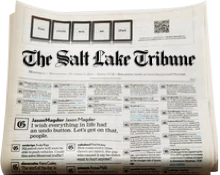This is an archived article that was published on sltrib.com in 2011, and information in the article may be outdated. It is provided only for personal research purposes and may not be reprinted.
It's one of the more puzzling aspects of American life that we sometimes need an outsider to show us to ourselves — which the footage from Swedish journalists compiled in the fascinating documentary "The Black Power Mixtape 1967-1975" does quite powerfully.
Much of what director Göran Olsson has compiled, shot by more than a dozen Swedish journalists, is stuff that was most likely ignored by the mainstream American media, and stuff they don't usually teach in schools.
The documentary starts in 1967, with the words of Stokely Carmichael, the black activist who told the Swedes that he didn't agree with the nonviolent resistance espoused by Martin Luther King, because "I'm not as patient as Dr. King, or as merciful." In a speech, Carmichael pinpoints the weakness he sees in nonviolence, because for it to work "your opponent must have a conscience. The United States has none."
From there, the movie goes year by year through an alternate history of the United States, from the viewpoint of the Black Power movement.
When King and Bobby Kennedy are assassinated in 1968, Richard Nixon is elected president — and two American athletes raise the Black Power fist salute on the medals stand of the Mexico City Olympics. In 1969, while America celebrates Apollo 11 reaching the moon, the Black Panther Party is establishing education programs and free food for the poor (a program the FBI's J. Edgar Hoover declares "the most dangerous internal threat" to America). And so on, through the years.
At times, the Swedes' outsider viewpoint is challenged. There's a comical, in retrospect, sequence in which Merrill Panitt, an editor at TV Guide, blasts Swedish TV for "portraying America as an evil country run by evil men." That archive interview is followed by an interview by filmmaker Emile de Antonio, who points out to the Swedes that TV Guide's publisher, Walter Annenberg, was also ambassador to the United Kingdom and a major contributor to Nixon's presidential campaign.
As the footage continues — through the hostage incident at New York's Attica prison, activist Angela Davis' trial on charges of supplying guns to a courthouse killer, to the rise of drug addiction in the black community — it's intercut with audio commentaries from this decade, from figures such as musicians Erykah Badu, Questlove and John Forte. These trenchant observations illuminate how confusing the late '60s and early '70s were in retrospect, and how the meaning of that time is still open to interpretation.
"The Black Power Mixtape 1967-1975" doesn't offer comprehensive history, nor does it try to. It's simply a series of snapshots, a series of memories of a tumultuous time, seen from the focused lens of outsiders looking in.
Twitter: @moviecricket
HHHhj
The Black Power Mixtape 1967-1975
A fascinating compilation of recent American history, seen from an outsider's viewpoint.
Where • Tower Theatre.
When • Opens Friday, Nov. 4.
Rating • Not rated, but probably R for language and images of violence.
Running time • 96 minutes; partly in Swedish with subtitles.

